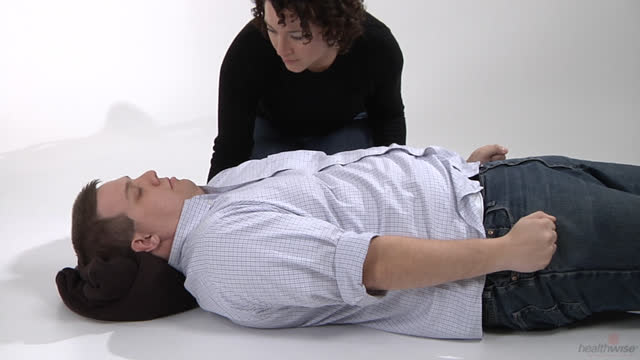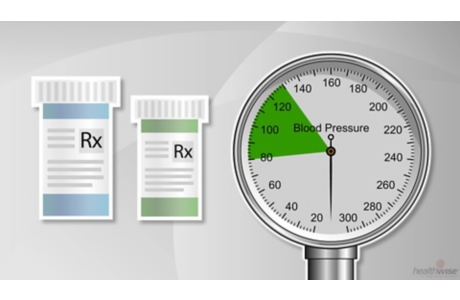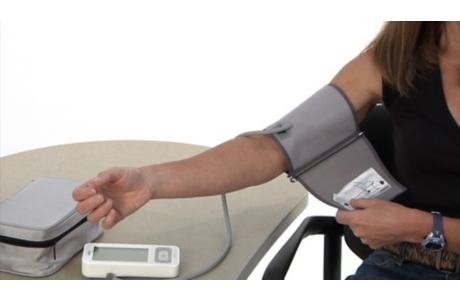Condition Basics
What is preeclampsia?
Preeclampsia is high blood pressure and signs of organ damage, such as protein in the urine, usually after 20 weeks of pregnancy. If it's not managed, it can harm you or your baby and lead to dangerous seizures (eclampsia). Preeclampsia usually goes away after the baby is born. But symptoms may last or appear after delivery.
What causes it?
Experts don't know the exact cause of preeclampsia. It seems to start because the placenta doesn't grow the usual network of blood vessels deep in the uterine wall. This leads to poor blood flow in the placenta. It's not clear what causes this placenta problem and why high blood pressure develops.
What are the symptoms?
Mild preeclampsia usually doesn't cause symptoms. But it may cause rapid weight gain and sudden swelling of the hands and face. Severe preeclampsia causes symptoms such as a very bad headache and trouble seeing and breathing. It also can cause belly pain and decreased urination.
How is it diagnosed?
Preeclampsia is usually found during a routine prenatal visit. That's one reason it's important to go to all of your visits.
At each prenatal visit, you'll be weighed and your blood pressure will be measured. An increase in blood pressure often is the first sign of a problem. If you are at high risk for preeclampsia, you may have other tests, such as blood tests and a test to check for protein in your urine.
If tests suggest that you have preeclampsia, you'll be carefully checked for the rest of your pregnancy. Your baby's health also will be closely watched. The more severe your condition is, the more often you'll need testing. This might range from once a week to daily.
How is preeclampsia treated?
If you have mild preeclampsia, you'll have frequent office visits and testing to check you and your baby. The doctor may want you to check your blood pressure at home. And you'll need to watch for signs of preeclampsia, such as a severe headache or vision changes.
If your preeclampsia is severe or getting worse, you may need to be in the hospital. Your doctor will closely monitor you and your baby. You may get medicines to lower your blood pressure and prevent seizures. You may get medicine to help prepare your baby's lungs for birth.
Your doctor will try to deliver your baby when your baby has grown enough to be ready for birth. But sometimes early delivery is needed to protect your health or your baby. If this happens, your baby will get special care for premature babies.
Preeclampsia often goes away after delivery. But sometimes symptoms last or get worse after delivery.
Health Tools
Health Tools help you make wise health decisions or take action to improve your health.
What Increases Your Risk
Some things increase your risk of preeclampsia. For example, your risk is higher if you:
- Have chronic (ongoing) high blood pressure, chronic kidney disease, certain autoimmune diseases, or diabetes.
- Had high blood pressure in a past pregnancy, especially before week 34.
- Had preeclampsia before.
- Have a family history of preeclampsia.
- Were very overweight when your baby was conceived.
- Are pregnant with more than one baby (such as twins or triplets).
- Are pregnant for the first time ever.
- Are older than 35.
Prevention
If you have risk factors for preeclampsia, it may help to:
- Take low-dose aspirin if your doctor recommends it.
- Get regular exercise if your doctor say it's okay. Try to do at least 2½ hours a week of moderate exercise. One way to do this is to be active 30 minutes a day, at least 5 days a week. Doing things like walking or swimming can be healthy for you and your baby.
- Eat a variety of healthy foods. Include plenty of foods high in calcium, such as dairy products, almonds, and dark leafy greens.
It's important to go to all of your prenatal visits. This helps your doctor find and treat problems early. This may help you avoid preeclampsia.
Learn more
Watch
Symptoms
Mild preeclampsia usually doesn't cause symptoms. But it may cause symptoms such as:
- Swelling of the hands and face that doesn't go away during the day.
- Rapid weight gain—more than 2 lb (0.9 kg) a week.
Severe preeclampsia can cause:
- A severe headache that will not go away with medicine such as acetaminophen.
- Blurred or dimming vision, spots in the visual field, or periods of blindness.
- Decreased urination—less than 2 cups (500 mL) in 24 hours.
- Lasting belly pain or tenderness, especially on the upper right side.
- A change in mental state, such as confusion or anxiety.
- Trouble breathing, especially when lying flat.
- Seizures. Severe preeclampsia can lead to seizures (eclampsia). Eclampsia is dangerous for both you and your baby.
What Happens
Preeclampsia affects your blood pressure and can also affect your placenta, liver, blood, kidneys, and brain. Preeclampsia can be mild or severe. And it may get worse gradually or quickly.
If your preeclampsia is mild, you may only need more frequent prenatal visits and testing. You may be able to carry your baby to term. If your preeclampsia becomes severe, you may need to deliver your baby early. Your doctor may induce labor or deliver your baby with surgery (cesarean section).
Preeclampsia often goes away after delivery. But sometimes symptoms of preeclampsia may last or get worse after delivery. In rare cases, symptoms don't show up until days or even weeks after childbirth.
After you've had this condition, you have an increased risk of high blood pressure, heart disease, stroke, and kidney disease. To protect your health, work with your doctor to have a heart-healthy lifestyle and get the checkups you need.
Complications of preeclampsia
When you have preeclampsia, it's very important to get treatment. That's because both you and your baby could have serious problems that involve your:
- Blood pressure. The force of blood against your artery walls goes up, raising your blood pressure. Very high blood pressure keeps your baby from getting enough blood and oxygen. Also, the amount of blood needed doesn't increase as much as it should during pregnancy. This can affect the baby's growth and well-being.
- Placenta. The blood vessels of the placenta don't grow deep into the uterus as they should. And they don't widen as they normally would. So they can't provide normal blood flow to the baby.
- Liver. Poor blood flow to your liver can cause liver damage. If the liver isn't working as well as it should, you could develop HELLP syndrome. This condition requires emergency medical treatment.
- Kidneys. When affected by preeclampsia, the kidneys can't work as well as they should to get rid of waste and extra water.
- Brain. Vision problems, a headache that won't go away, and seizures (eclampsia) can develop. Eclampsia can be dangerous to you and your baby. It can lead to a coma and death. That's why people who have preeclampsia are often given medicine to prevent eclampsia.
- Blood. Low platelet levels in the blood are common with preeclampsia. In rare cases, a dangerous blood-clotting and bleeding problem develops along with severe preeclampsia. This condition is called disseminated intravascular coagulation (DIC). You may be given medicine, a blood transfusion, or a platelet transfusion. DIC goes away after delivery.
Problems for the baby
The earlier in the pregnancy that preeclampsia starts and the more severe it gets, the greater the risk of preterm birth. A preterm birth can cause problems for the newborn. For example, a baby born before 37 weeks may have trouble breathing because of immature lungs (respiratory distress syndrome). You may be given medicine before delivery to help prevent lung problems.
A newborn affected by preeclampsia may also be smaller than normal. This is because the baby may not get enough nutrition due to poor blood flow through the placenta.
Learn more
Watch
When to Call a Doctor
Share this information with your partner or a friend. They can help you watch for warning signs.
Call 911 anytime you think you may need emergency care. For example, call if:
- You passed out (lost consciousness).
- You have a seizure.
- You have trouble breathing.
- You have chest pain.
Call your doctor now or seek immediate medical care if:
- You have symptoms of preeclampsia, such as:
-
- Sudden swelling of your face, hands, or feet.
- New vision problems (such as dimness, blurring, or seeing spots).
- A severe headache.
- Your blood pressure is very high, such as 160/110 or higher.
- Your blood pressure is higher than your doctor told you it should be, or it rises quickly.
- You have any vaginal bleeding.
- You have new nausea or vomiting.
- You think that you are in labor.
- You have pain in your belly or pelvis.
- You gain weight rapidly.
Watch
Exams and Tests
Preeclampsia is usually found during regular prenatal checkups. That's one reason it's important to go to all of your prenatal visits. Tests are done at each visit to check for preeclampsia, including:
- Blood pressure reading.
Blood pressure is always watched closely during pregnancy.
- Weight measurement.
Rapid weight gain can be a sign of preeclampsia.
If you're at high risk for preeclampsia, you may also have other tests, including:
- Urine tests.
Too much protein in the urine can be a sign of kidney damage caused by preeclampsia.
- Blood tests.
These may be done to check for problems such as HELLP syndrome and kidney damage.
Follow-up testing
If tests suggest that you have preeclampsia, you'll be carefully checked for the rest of your pregnancy. Your baby's health also will be closely watched. The more severe your preeclampsia is, the more often you'll need testing. This might range from once a week to daily.
At prenatal visits, you may have a physical exam to check for signs that preeclampsia is getting worse. You may also have urine tests and blood tests to check for blood problems and kidney damage.
Tests to check on your baby may include:
- Fetal heart monitoring to record your baby's heart rate.
- Fetal ultrasound to check the baby, the placenta, and the amount of amniotic fluid.
- Doppler ultrasound to see how well the placenta is working.
Learn more
Watch
Treatment Overview
If you have mild preeclampsia, you will have frequent office visits. Your doctor will check on your baby, monitor your blood pressure and weight, and do urine and blood tests. The doctor may also want you to check your blood pressure at home. And you'll need to watch for symptoms of preeclampsia, such as a severe headache or vision changes.
If preeclampsia is severe or getting worse, you may need to be treated in the hospital. Your doctor will closely monitor you and your baby. You may get medicines to lower your blood pressure and magnesium sulfate to prevent seizures. You also may get medicine to help prepare your baby's lungs for birth.
Delivery
Your doctor will try to deliver your baby when the baby has grown enough to be ready for birth. But sometimes early delivery is needed to protect your health or your baby. If this happens, your baby will get special care for premature babies.
- If you are near full term or have severe preeclampsia, your doctor will plan to deliver your baby as soon as possible.
- If you are less than 34 weeks pregnant and a 24- to 48-hour delay is possible, you will probably get corticosteroid medicine. This can help prepare your baby's lungs for birth.
A vaginal delivery is usually the safest way to deliver the baby. It is tried first if you and your baby are both stable. A cesarean section (C-section) is needed if your preeclampsia is quickly getting worse or your baby can't safely handle labor contractions.
Care after birth
If you have moderate to severe preeclampsia, your risk of seizures (eclampsia) continues for the first 24 to 48 hours after childbirth. So you may keep getting magnesium sulfate after delivery.
Preeclampsia usually goes away after delivery. But sometimes symptoms may last or get worse after delivery. In rare cases, symptoms of preeclampsia don't show up until days or even weeks after childbirth.
If your blood pressure is still high after delivery, you may be given a blood pressure medicine. You will have regular checkups with your doctor. If you didn't have high blood pressure before pregnancy, your blood pressure is likely to return to normal a few days after delivery.
After having preeclampsia, you have a higher risk for high blood pressure, heart disease, stroke, and kidney disease. To protect your health, work with your doctor to build heart-healthy habits and get the checkups you need.
Learn more
Self-Care
- Monitor yourself for symptoms of preeclampsia. Call your doctor if you have symptoms such as a severe headache, vision changes, or sudden swelling in your face and hands.
- Take and record your blood pressure at home if your doctor tells you to.
- Ask your doctor to check your blood pressure monitor to be sure that it is accurate and that the cuff fits you. Also ask your doctor to watch you to make sure that you are using it right.
- Don't eat, use tobacco products, or use medicine known to raise blood pressure (such as some nasal decongestant sprays) before you take your blood pressure.
- Avoid taking your blood pressure if you have just exercised or if you're nervous or upset. Rest at least 15 minutes before you take your blood pressure.
- Take your medicines exactly as prescribed. Call your doctor if you think you are having a problem with your medicine.
- If you smoke, quit or cut back as much as you can. Smoking and vaping can be harmful to your baby. Talk to your doctor if you need help quitting.
- Eat a variety of healthy foods. Include plenty of foods high in calcium, such as dairy products, almonds, and dark leafy greens.
- Talk with your doctor about how much weight gain is healthy for you. Gaining too much weight while you're pregnant may be harmful.
- If your doctor recommends it, keep track of your baby's movement. A common method is to note the length of time it takes to count 10 movements (such as kicks, flutters, or rolls). Call your doctor if you don't feel at least 10 movements in a 2-hour period. Track your baby's movements once each day. Bring this record with you to each prenatal visit.
Learn more
Watch
Medicines
If you have preeclampsia, you may take medicine to:
- Control high blood pressure.
Your doctor may prescribe blood pressure medicine if your blood pressure reaches high levels that may be dangerous to you or your baby. But lowering high blood pressure doesn't prevent preeclampsia from getting worse. High blood pressure is only a symptom of preeclampsia. It's not a cause.
- Prevent seizures.
Magnesium sulfate may be started before delivery and continued after delivery if you have moderate to severe preeclampsia. It can help prevent seizures (eclampsia).
- Speed up your baby's lung development.
When possible, steroid medicine is given before a premature birth. It helps the baby's lungs to mature over a 24-hour period. This lowers the baby's risk of breathing problems after birth.
Learn more
Related Information
Credits
Current as of: July 10, 2023
Author: Healthwise Staff
Clinical Review Board
All Healthwise education is reviewed by a team that includes physicians, nurses, advanced practitioners, registered dieticians, and other healthcare professionals.
Current as of: July 10, 2023
Author: Healthwise Staff
Clinical Review Board
All Healthwise education is reviewed by a team that includes physicians, nurses, advanced practitioners, registered dieticians, and other healthcare professionals.










